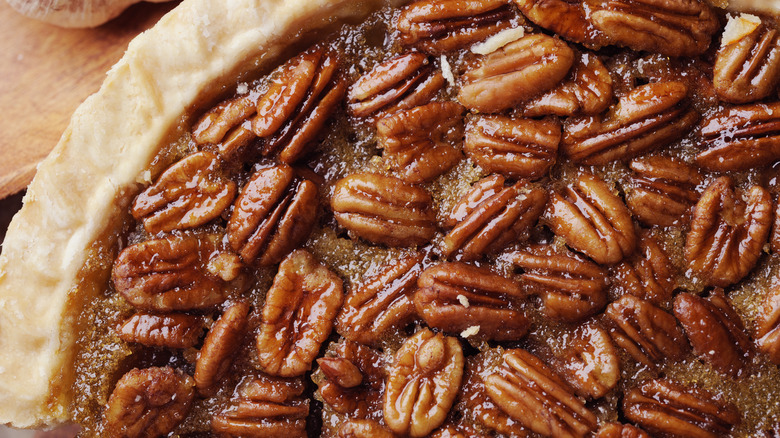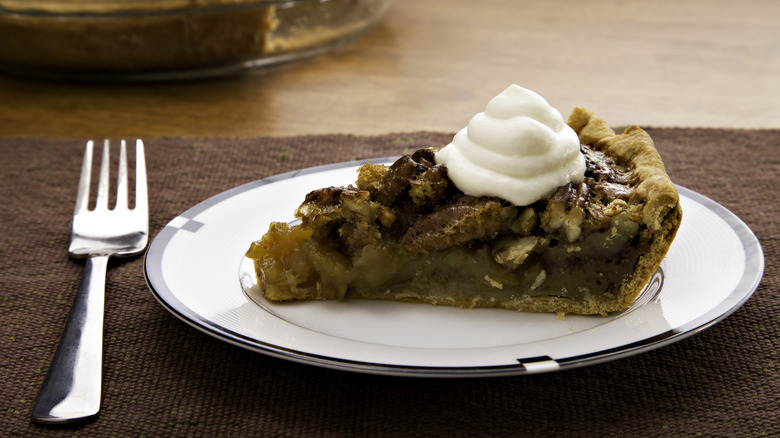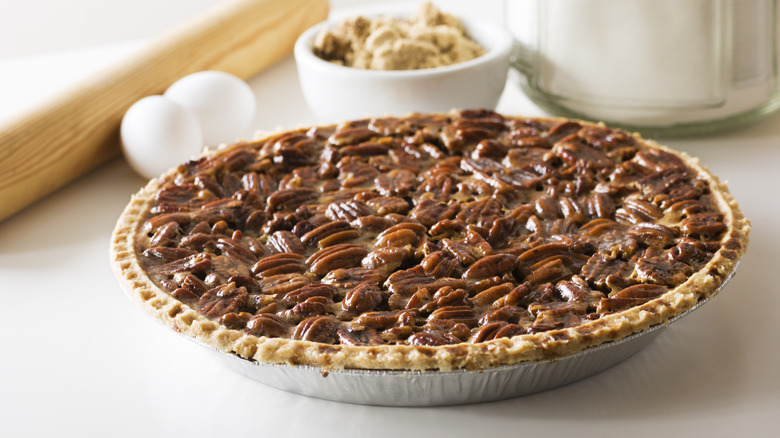The Baking Test To Check If Your Pecan Pie Is Done
The holiday season is often considered the baking season, which usually means you'll be making several holiday pies. In addition to predictable pumpkin, you might want to bake that Southern delicacy, pecan pie. Scrumptious and satisfying, pecan pies are different from many of their fellow pies: Their filling is not made from fruit or custard, and when taken out of the oven, it can look done but actually be undercooked — and trust us, a runny pecan pie filling can put you off dessert. And an overbaked disc isn't any more appetizing.
So, how do you know if your pecan pie has cooked through? The recommended internal temperature for a fully baked pecan pie is 200 degrees Fahrenheit. If you don't have a kitchen thermometer handy, there are several non-thermometer strategies for testing your pecan pie filling. From checking for "springiness" and amount of jiggle to the time-tested "clean knife" test, there are a variety of indicators that your filling has reached the sweet spot for holding together without being either runny or crumbly.
It's a sugar pie, honeybunch
At first glance, pecan pies most closely resemble custard pies because of the presence of beaten eggs, and the eggs are what help give pecan pie filling its structure when properly cooked. But in the South, pecan pies belong to a family of bakes known as sugar pies, all of which consist of sugar, eggs, and flavorings. Therefore, it's possible to make a pecan pie with maple syrup or even molasses — they're all dogs running in the same pack.
This is why you want the middle to be jiggly when you take your pecan pie out of the oven: The filling's sugars are still a little liquified and will set as they cool. Lightly pressing on the center of the pie is a nearly foolproof way of testing if the filling is sufficiently baked. The filling in a pie that's baked will spring back when pressed; the middle of an underbaked pie will cave in under the pressure — and that pie is likely to have a runny filling and soggy crust. If there's no give or spring at all to the middle of your pecan pie, it's likely overbaked and the center will be more like a crumbly cookie than a luscious sugar pie.
Gettin' jiggly with it
A fully cooked pecan pie will give you other clues to its level of doneness. One thing to look for is a pleasing caramel-brown color on top and a slight puffiness around the crust. If your pie looks pale and anemic, it's probably underbaked so slide it back into the oven for a few more minutes. By the same token, a dark brown top and crust likely means the pie has been overbaked. In addition to appraising color and appearance, giving your pecan pie a little shake can give you a clue to doneness. If the filling is wobbly, it probably needs more time in the oven. An immovable center, especially while the pie is still hot, means it should have already been taken out of the oven.
It's important for many reasons to have a kitchen thermometer (seriously, go ahead and buy one), but it's also nice to develop that fingertip feel for when a pecan pie is properly baked. Great cooks have a sixth sense for many culinary things but trust us that these apparent instincts are learned, not inherited.


